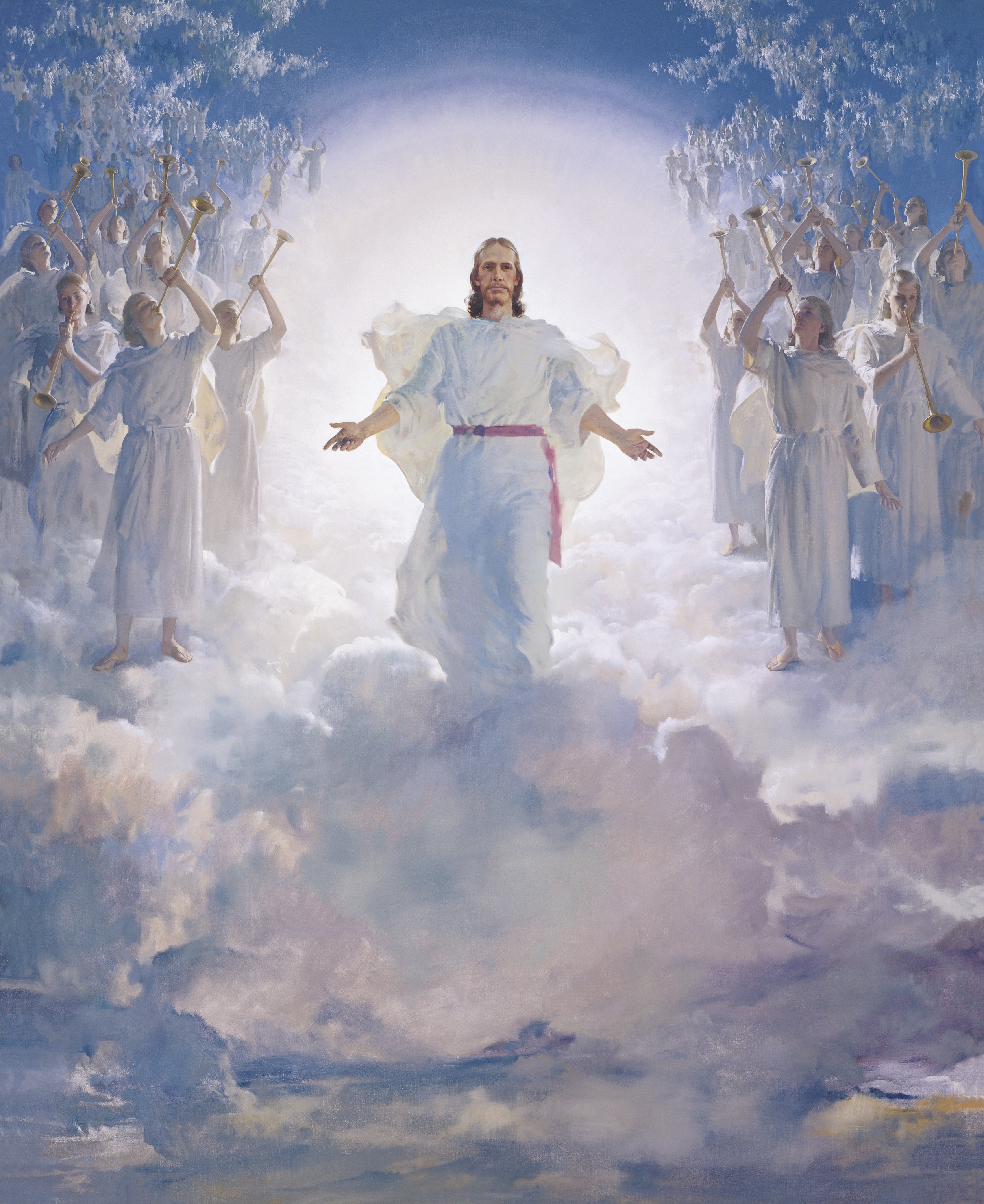Lo, he comes …
“Prepare the way of the Lord, and make his paths straight.”
As a Seventh-day Adventist, Harry Anderson's artistic imagination was steeped in biblical imagery and Adventist end-times fervor. This backdrop informed his serene yet intense visualization of The Second Coming (1952) currently housed in the LDS Museum of Church History and Art. (Indeed, as a quirk of the history of American Christian art, this image -- while it is very much representative of an generically American Christian imagination -- is widely and principally reproduced in Mormon contexts.)
Jesus stands robed in white, arms outstretched amidst the clouds. Surrounding him is a host of angels, triumphantly heralding his return on elongated brass horns. As our eyes drift from Christ as the central figure to his angelic consort, we see the white-clad band fading into the distance, becoming indistinguishable from clouds that punctuate the vivid blue sky.
The peaceful expression on Christ's face is not angry, but neither is it particularly merciful. There are no humans depicted in this scene, neither saints nor mortals; the damned nor those who receive mercy. The viewer is left to encounter Christ and his angels personally, within the tunnel of his or her own vision: to look towards angelic welcoming committee that is absorbed into the firmament, their sound resonating through the heavens. The vivid colors, soft lighting, and meticulous realism create a mood of intimate rapturous intensity, but it is a different mood, and different impression than we encounter in so much of the artistry of the last things, which is tied up with the grandeur of God and the scope of righteous judgement, evoking awe and wonder.
Anderson's technical mastery is irrefutable, but his realism is almost ... too real. The rich, symbolic language of Scripture is reduced into a personal polaroid. The individual soul is left hanging with Jesus, somewhere in the clouds, in a "personal relationship" that is neither robustly queued towards the righteousness of God, nor attuned to the extraordinary drama of his mercy. Perhaps Anderson's Adventist upbringing causes him to fixate more on rapture than incarnation, tribulation than consolation. This week's scriptures call us to patient waiting not dread; joyful expectation, not of tense anticipation. As we await God's inbreaking, may we recover a spirit of childlike longing, setting aside our ever-imperfect imaginations of Christ's coming to receive him afresh and anew in the ever-strange ways he comes to us.
Comfort, comfort my people, says your God.
— The Prophet Isaiah (Isa 40:1)
Second Sunday of Advent
Texts for this Week
Prayer
Blessed Lord, who caused all holy Scriptures to be written for our learning: Grant us so to hear them, read, mark, learn, and inwardly digest them, that by patience and the comfort of your holy Word we may embrace and ever hold fast the blessed hope of everlasting life, which you have given us in our Savior Jesus Christ; who lives and reigns with you and the Holy Spirit, one God, for ever and ever.
Nun komm, der Heiden Heiland - Savior of the Nations, Come!
The Gesualdo Six — a UK-based ensemble specializing in English Renaissance music — sing perhaps the most classic Advent hymn of the Reformation. This well-beloved text emerged from the pen of Martin Luther himself, a prayerful Advent poem pleading "Savior of the Nations, come." Here, it is set by Michael Praetorius (d. 1621) for 4-part acapella choir. The lush and rhythmic harmonizations Praetorius adds to Luther's text create a resonant musical space for prayer and reflection, much like this week's scriptures open up room for quiet anticipation.
When Isaiah 40 speaks God's words of comfort and promise, it is an oasis of hope breaking into despair, a balm after grievous hardship. The psalmist finds similar consolation celebrating God's "salvation now near." And Mark's account of John the Baptist levels pride to make straight the path for Christ's coming, fulfilling Isaiah's words. Gentle but urgent Advent longing pulses through all these texts.
Likewise, Praetorius' setting gives this longing a home, putting melodic flesh onto the raw yearning of Luther's Nun komm. As the choral work progresses, the interweaving independent voices create moments of unexpected but lovely harmony. New depths emerge from the counterpoint, imaging the Holy Spirit's work to transform earth's dissonant cries into harmonies that echo the tones of heaven. The Advent plea "Come now!" undergirds all. May Praetorius' musical setting attune our hearts to join this chorus.
Introitus
Populus Sion
This week’s introit comes from Isaiah 30:19 and Psalm 80:1. Here is a translation of the Latin from the antiphoner:
People of Zion, behold! The Lord shall come to save the nations: and the Lord shall make the glory of His voice to be heard, in the joy of your heart. Ps. Give ear, O Shepherd of Israel: you that lead Joseph like a sheep.
Here it is, sung by the by the Congregation of St. Lazarus Autun; and here is a simple English version of the chant. And while we’re at it, Dutch Renaissance composer Heinrich Isaac (d 1517) composed a polyphonic setting of the introit so popular that it inspired a guitar arrangement by Noel Akchote.



